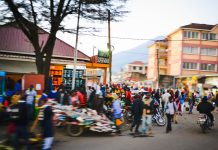As the most robust economy in Central Africa, Cameroon, has in the past decade taken steps to further boost growth, making major advances in providing health, education, and clean water, and launching an ambitious infrastructure investment programme to become a middle-income country by 2035, according to the AfDB’s Cameroon Country Brief released on 2 November 2017.
The report highlights the country’s efforts towards achieving this objective, with the Bank’s support, by aligning its development actions to AfDB High 5 strategic pillars.
“Progress has been impressive, but a big leap in business competitiveness is required, to create a more diverse, inclusive, regional economy,” said Simon Mizrahi, Director of the Delivery, Performance Management and results.
Here are a few highlights and insights from the report:
- Light Up and Power Cameroon: With abundant sun, rivers, and natural gas reserves, Cameroon could potentially be an electricity exporter to the Central African Economic and Monetary Community (CEMAC). But for now, the country must address domestic power shortages, strong annual demand growth of 8%, and low electricity access in rural areas. As of next year, however, 2.7 million Cameroonians will have better electricity access, due to a national plan to expand production and transmission with AfDB’s support.
- Feed Cameroon: To fulfill its potential in agriculture, which accounts for 40% of GDP, , the AfDB has helped Cameroon double agriculture output, which has lifted the livelihoods of 4.6 million farmers by 15%, including promoting small holders agribusiness, better nutrition, and strengthening food security.
- Industrialise Cameroon: The economy rebounded to 5.7% growth in 2015, boosted by agribusiness and construction, and the time to start a business shrank to 15 days from 45. However, the country should cut red tape and make it easier for businesses to get loans. Internet use rose 10-fold but stands at 11%, although that will grow: the Central African Backbone will install 1,000 km of fiber optic cables with AfDB financing.
- Integrate Cameroon: Intra-Africa trade tripled in the past decade, but a big investment gap remains to build transport, energy, and information and communications infrastructure to underpin further growth. Recent trade growth was boosted by an AfDB-backed road, the 535 km corridor in the fertile zone from Bamenda in Cameroon to Enugu in Nigeria, which cut travel time to hours instead of days, and lifted the incomes of traders and farmers.
- Improve the Quality of Life for Cameroonians: Despite investing heavily in health centers, schools, and clean water – only three-quarters of the population currently have clean drinking water – Cameroon must create more jobs, especially for its youth.
To better serve Cameroon, AfDB has recently expanded its Yaounde office, striking new partnerships to leverage more financing, and raising its investment to $2.8 billion.
Looking forward, Cameroon has several ambitious endeavours in its bid to narrow the investment gap in trade, energy, and transport, and to further expand its position as the largest regional trading partner in Central Africa, though projects, such as the AfDB-funded study on the Cameroon-Chad electricity Interconnection Line, one of the largest projects in the Economic community of Central African States (ECCAS).
The Country Brief is available here.






































